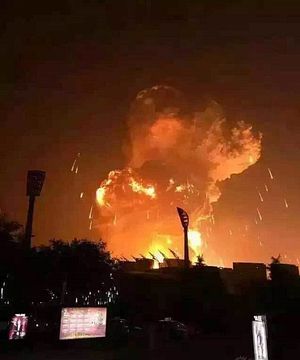An investigation by China’s State Council found 123 people responsible for the explosions that rocked Tianjin last August, Xinhua reported today. The August 12 explosions, which occurred at a chemical warehouse operated by Tianjin Ruihai International Logistics Co. Ltd., left 165 dead and hundred more injured.
Reporting in the immediate aftermath pointed to lax enforcement of public safety regulations, as well as shady dealings by Ruihai and local officials to circumvent the law. In response, China’s central government promised a full investigation, and pledged to focus on correct enforcement of safety regulations throughout the country.
Premier Li Keqiang was briefed on the investigation’s preliminary findings back in September. The preliminary report found “irregularities and illegal operations by the companies involved, and acts of corruption and dereliction of duty on the part of relevant departments.” Li himself promised that the people responsible would be “held accountable and punished in accordance with law and discipline.” At the time, the government had already begun investigations into 23 people, from executives at Ruihai Logistics to government officials.
The State Council’s report, however, casts its net much wider, identifying 123 people as responsible for the Tianjin explosions. Of those, the investigation team recommended 74 people undergo Party discipline, with another 48 to be “admonished” by their local Party apparatus (the 123rd person apparently passed away during the investigation). Party members are subject to criminal investigation as well, once Party discipline takes it course.
The report also set the cost of the explosions, with “verified, direct economic losses,” at a total of 6.87 billion renminbi (just over $1 billion). That includes damage to “304 buildings, 12,428 cars and 7,533 containers,” according to Xinhua. The extent of the damage led the State Council to label the explosions “an extraordinarily serious” accident.
Unsurprisingly, Ruihai Logistics, the company that owned the warehouse, bore the brunt of the responsibility. The State Council report said that Ruihai Logistics “illegally built a freight yard of hazardous materials, conducted illegal operations, illegally stored hazardous material, and had been running inept safety management.” That conclusion fits with earlier reports from Chinese state media outlets, which accused Ruihai executives of having used political connections to get around safety inspections and other regulations.
The report recommends that Ruihai Logistics have its licenses revoked, and that executives who worked for the company be banned from taking up other high-ranking posts in the industry.
Yet in the six months it took to investigate the Tianjin case, another fatal industrial accident shocked the nation: a deadly landslide in Shenzhen, caused by the collapse of an illegal construction waste dump. The December 2015 incident, which killed 69, has sparked the same response of investigations, prosecutions, and promises to upgrade safety; by mid-January, a dozen government officials and 16 businesspeople had been charged in the Shenzhen case.
The question now is whether China can make the transition from punishment to prevention of such accidents, both of which were strongly tied to corruption and lax regulations.

































